
|
Ballpark HistoryWalter O’Malley forever changed the landscape of baseball when he moved Brooklyn’s beloved bums to the West Coast after spending years trying to convince the New York City borough to replace Ebbets Field, with which he was dissatisfied because of its low seating capacity (32,000) and available parking spaces (700). Ebbets Field was crammed into the Flatbush neighborhood, which allowed no room for expansion, and O’Malley went west to find what he was looking for. While on a helicopter tour of Los Angeles on May 2, 1957, the Dodgers owner flew over Chavez Ravine and saw a plot of land where he envisioned freeway access to a ballpark from all directions. The city of Los Angeles was happy to help O’Malley realize his vision and four months later an agreement was struck between the two parties whereby the mostly undeveloped plot was given to the Dodgers in exchange for the team’s commitment to build a 50,000-seat stadium on the land. The irony of O’Malley’s choice was that it was picked primarily because of its convenience to LA’s highway system, when the Dodgers themselves were named for the mass transit streetcars they left behind in Brooklyn following the 1957 season. By then, O’Malley had already secured territorial rights to the LA market (he had purchased the Cubs’ minor league franchise in Los Angeles in February of 1957). That paved the way for the Dodgers to play at 93,000-seat Memorial Coliseum while Dodger Stadium was being built.
Construction Architect Emil Praeger quite literally had his work cut out for him, as O'Malley’s desire to build the stadium on the side of Chavez Ravine necessitated the removal of 8 million cubic yards of earth. Original plans for Dodger Stadium included a huge fountain in center field and the stadium was actually designed to be expandable to a capacity of 85,000 seats, which would be accomplished by enclosing the outfield pavilion. Neither idea ever came to fruition and Dodger Stadium opened in 1962 with 56,000 seats, same as today. The price tag of $23 million was privately funded, making Dodger Stadium the only privately financed ballpark built in a span of 75 years.
Location and ParkingDodger Stadium is one mile north of downtown Los Angeles, perched atop the hillside on the edge of Chavez Ravine that overlooks the city. Its light towers are visible from I-5 a couple miles before the Stadium Way exit and, just as Walter O’Malley imagined, the ballpark is serviced by multiple freeways. To get to the stadium automobiles traverse through Elysian Park or a local neighborhood (depending on which freeway exit you take) to ascend to one of the stadium’s many entrance points, where lines of cars await admission at theme park-like gates. You pay an attendant $15 to enter Dodger Stadium and are then directed to park in one of 21 terraced lots.
Fittingly, Dodger Stadium is the only Major League ballpark to have a gas station on its premises, as a Union 76 is located not too far behind the outfield bleachers. Gas prices aren't hiked up much, but the station doesn't stay open very long after ballgames. Despite the closeness of the vast concrete lots outside, patrons inside the stadium are treated to panoramic views of the tree-lined Elysian hills and a silhouette of the distant San Gabriel Mountains. Fans in the top deck have what is probably the best view of the Los Angeles skyline in the city available to them from their upper level concourse. More than 3,000 trees are located on stadium property and landscaping is maintained by a full-time staff of gardeners, making Dodger Stadium one of the most picturesque venues in baseball.
Free Parking:
Dodger Stadium OverviewThe stadium has five tiered levels of grandstand seating, but its most recognizable feature is the pavilion outfield bleachers and their wavy roof. The retired numbers of eight Dodgers players and two managers are mounted underneath the famed zigzag roof. The modern Dodger Vision scoreboard is attached to the light tower in the left field pavilion while the vintage matrix board is affixed to the pavilion’s other light tower in right-center.
The Think Blue sign, a takeoff of the famous Hollywood sign, is easily visible in the hills behind the ballpark. The Dodgers also print their “Think Blue” mantra on ticket stubs. Palm trees sway behind each of the foul poles and the view from most seats showcases the natural beauty of Chavez Ravine’s tree covered hills. The panoramic landscape is complete on a clear day, when the San Gabriel Mountains are visible. The members only Dodger Stadium Club restaurant is noticeable at the end of the first base grandstand, and each of the Dodgers’ six world championship years is listed on the façade below the club-level restaurant. The stadium’s concourse and aisles are roomy, but lines at the concession stands are absurdly long. If there’s a good crowd expect to miss an inning waiting for food, which many people do to get the famous foot long Dodger Dog, the top selling hot dog in baseball. Dodger Stadium looks big, but feels surprisingly intimate. That’s because it has the smallest lower deck of any modern stadium, meaning that the higher decks are positioned much closer to the infield than normal. As a result, sitting in the upper deck’s infield and lower reserve seats doesn’t feel that high up. The overall size of Dodger Stadium is evident when trying to get inside it. The ballpark’s multiple levels each have their own gates and ticket booths, and you can enter only through the gates on the level where your seat is located. To get to each level requires lots of footsteps up staircases, and just like a theme park there is plenty of signage with directions so fans can find particular seating levels. When you make it to your gate destination you’ll be welcomed, via a recorded announcement, by legendary Dodgers broadcaster Vin Scully. But once inside you can’t move down to lower levels. Furthermore, fans in the pavilion bleachers can’t access any other part of the stadium, nor are fans allowed into the pavilion unless they have a pavilion ticket. So if you like your ballpark experience to be nomadic, Dodger Stadium’s enforced seating policies will be frustrating. It’s hard to believe, but Dodger Stadium is the fifth oldest ballpark in the Major Leagues. For most of its existence it has undergone very little renovation. Seating capacity has never varied from the 56,000 it stared with in 1962 due to a conditional-use permit limiting capacity. If the Dodgers add seats they always remove an equal amount to keep the capacity the same. That’s what happened in 2000 when they added several rows of box seats in what was previously foul territory behind home plate and between the dugouts and the foul poles. In a corresponding move, the Dodgers covered the lower sections of pavilion seating closest to center field with a black tarp, which served the dual purpose of expanding the batter's eye backdrop and maintaining a 56,000-seat capacity. Not all of the recent renovations are about adding more high-priced field level box seats - although another 1,600 were added in 2005 – as the Dodgers replaced every seat in time for the 2006 season, and did so using the stadium's original pastel colors of yellow, light orange, turquoise, and sky blue. It’s fitting that Dodger Stadium has returned to its original seat colors, as the ballpark is a throwback to a bygone era when amenities were few and the focus was on the game. As such, there's no fan plazas, skyboxes or gimmicks to entice children out of their seats. It might not be quaint, but Dodger Stadium exudes a certain elegance from its simplicity that can’t be found in the modern ballpark. Regardless of era, Dodger Stadium is truly one of the classics in Major League Baseball.
Game AtmosphereDodger crowds are infamous for arriving in the 3rd inning and leaving in the 7th. There’s truth in that statement, but it has little to do with baseball. Los Angeles traffic is the reason Dodgers fans get a bad wrap. As I found out, you can arrive at the ballpark in the vicinity of the first pitch, but by the time you park, walk to the stadium, buy a ticket and find your seat…it’s the 3rd inning! Fans then start to leave in the later innings to avoid the gridlock that awaits in the parking lots, then on the access roads to the freeways, following the game. With late arrivals and early departures excused, I rate the crowds at Dodger Stadium as one of the most passionate in baseball. When the stadium is packed, they are certainly up there with Yankees fans as the loudest. There’s extra buzz in the stands when LA plays the Giants or Padres, as the rival fans dislike each other near Red Sox-Yankees proportions. There were so many heated exchanges and ejections in my section during a Padres-Dodgers game that I had to move to another section to watch the game in peace. Trust me, Dodgers fans are really into the game!
TicketsThe Dodgers are the only team I know of that charge extra money when you wait until the day of the game to buy tickets. Starting at 12:01 a.m. on the day of a game, ticket prices go up $5 in all sections but the premium seats, which are raised $10. Because there are so many seating levels (16 available to the public), prices vary widely but the reserve section is reasonable by today’s standards. The cheap seats are in the top deck, a 5th level mini-grandstand high above home plate, where tickets are just $10 on game day...or $324 for the season!
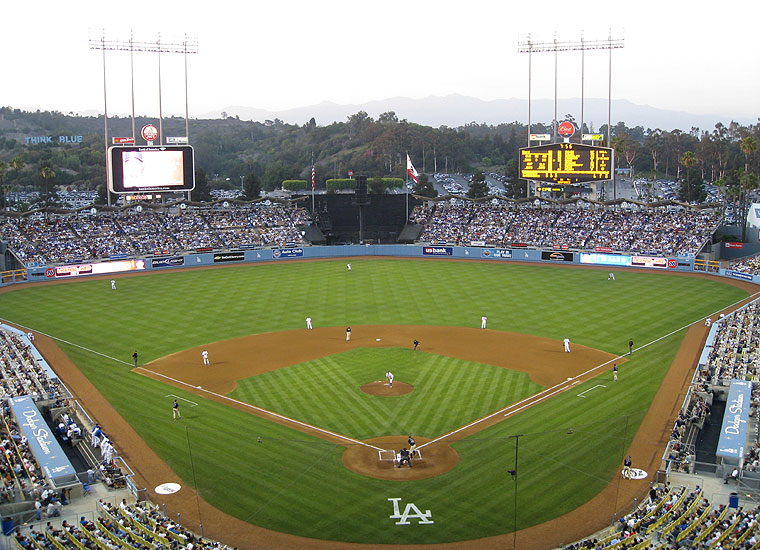
Dodger Stadium Footnotes - Facts & Figures
| ||||||||||||||||||||||||||||||||||||||||
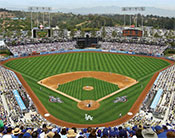
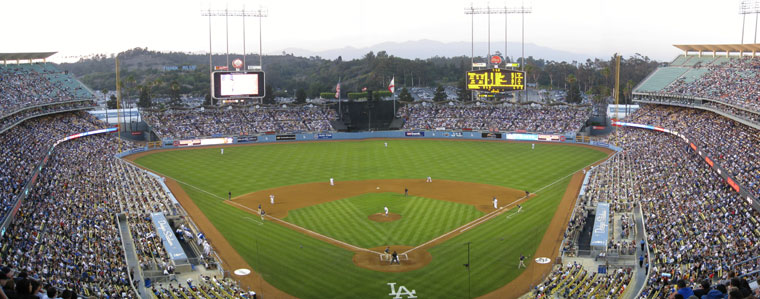
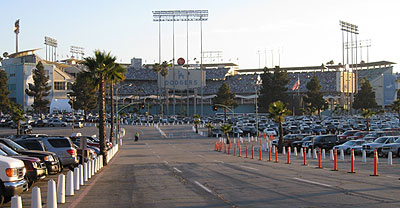 The sea of parking lots, which can hold 16,000 automobiles, takes up considerable space on the 300 acres of land that the Dodger Stadium complex occupies, and traffic lights are needed within the parking lots to preserve order.
The sea of parking lots, which can hold 16,000 automobiles, takes up considerable space on the 300 acres of land that the Dodger Stadium complex occupies, and traffic lights are needed within the parking lots to preserve order.
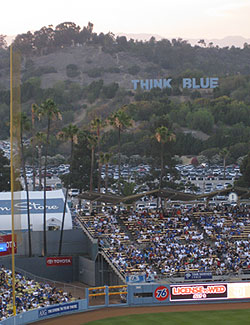 The bullpens (Dodgers in left, visitors in right) separate the pavilion bleachers from the grandstand, which was designed to be earthquake-resistant.
The bullpens (Dodgers in left, visitors in right) separate the pavilion bleachers from the grandstand, which was designed to be earthquake-resistant.

